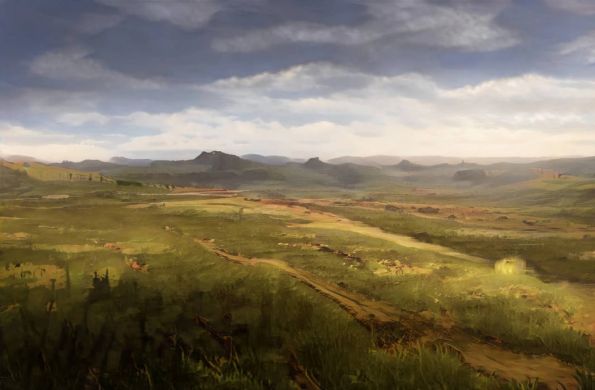Cumana
Cumana is a half-orc sanjak in the Tatar Steppe between the Dneiper and Don rivers, north of the Black Sea. The region borders on Moskva, Kiyev, the Ottoman Empire, Zaporozhia and minor states of Transcaucasia. The sanjak covers an area of 98.5 hexes, with a population of 337,782. Mutrakan, the largest city, has a population of 85,218.
Contents
History
Arrival of the Cumans
During the 9th and 10th centuries, tribes of pure-blood orcs and half-bloods migrated from the steppes below the Altai mountains, emerging north of the Caspian Sea in the 11th century. The Pechenegs came first, followed by Cumans and Kipchaks. The latter groups raided the Khazars and parts of eastern Rus, before sweeping over the Don River into Kiyevan lands. In 1061, the Cuman chieftain Sokal led his people into the heart of Kiyev, invading and devastating the Dneiper Bank, beginning a seasonal war that would last for 175 years. Raiding continued year after year, until the Kiyevan forces established a protective front in 1107.
The pureblood Kipchaks and half-orc Cumans formed a loose confederation after 1080, ruling over the lower Dneiper eastward to the Volga. They fought wars with the Rus, the Seljuk Turks and Circassians. In 1086, a huge Cuman and Pecheneg force defeated Alexius Comnenus of Byzantium in 1086, ravaging the entire eastern Balkan region, up to the walls Constantinople itself. In 1091, after two years of siege, Alexius bought the Cumans off, turning them against the Pechenegs. By 1126, the Pecheneg hets (chieftains) were broken and many of the people massacred.
Cuman Suzerainty
As Kipchaks interbred with Cuman tribes, the resultant battle-lusting clans exercised their influence from the Black Sea to Novgorod. The sack of Kiyev in 1169 enabled them to raid further afield, into Bessarabia, Ruthenia and even Hungary. For 20 years, Moldavia became a Cuman military camp, enabling attacks into Bulgaria and Wallachia into the 1190s.
However, the Cuman hets grew less cohesive with the 13th century, with large numbers hiring as mercenaries. Kipchak tribes, blending with Dwarves of the Donets valley and humans, grew passive and agrarian, settling the lower Don and Volga valleys.
Mongols
The approach of the haruchai general Temujin following the capture of Bokhara (1219) and Samarkand (1220), a combined force of Cumans and Russians weree destroyed at the battle of the Kalka River in 1223. The Kipchak tribes were obliterated and enslaved, while Cuman populations were scattered, slaughtered or forced to submit as members of Tatar clans. These latter were organized as a slave-army of the Khanate of the Golden Horde under Batu Khan between 1237 and 1240, occupying the lands which are today Cumana.
As the Haruchai Tatars maintained their grip on the Crimean Peninsula, adopting Islam, the Cumans embraced the Russian stand on the Ugra River in 1480. Adopting Eastern Orthodoxy, Ivan the III bequeathed them lands south and west of the Don River; this is the first historical use of "Cumana" to describe a political entity.
Sanjak of Cumana
Cumana would remain a client state of Russia until 1491, while still remaining friendly with the latter. The conquest of the Tatar state by the Ottomans would create a hundred years of conflict between Cumana and the Turks, until a settlement was reached in 1610; since that time, a yearly tribute has been paid to the Ottomans. Existing as a buffer state, Cumana survives so long as its friends and enemies hesitate to provoke an all out war between north and south. Both Moskva and the Ottomans have other more dangerous enemies; the maintenance of peace with Cumana offers both a relatively safe border.
Settlements
| Name | Population | Year founded | Province |
|---|---|---|---|
| Balakleya | 483 | 1264 | Cumana |
| Barvenshan | 450 | 1470 | Cumana |
| Bogodukhan | 640 | 1394 | Cumana |
| Chuson | 598 | 1411 | Cumana |
| Izyum | 973 | 1261 | Cumana |
| Kaskan | 660 | 1386 | Cumana |
| Kupyan | 805 | 1328 | Cumana |
| Merefa | 870 | 1302 | Cumana |
| Mutrakan | 85,218 | 1241 | Cumana |
| Olshan | 808 | 1327 | Cumana |
| Valki | 873 | 1301 | Cumana |
| Volkhan | 1,010 | 1246 | Cumana |
| Anor | 398 | 1491 | Donbass |
| Arkov | 304 | 1407 | Donbass |
| Kamut | 4,330 | 1336 | Donbass |
| Luka | 338 | 1515 | Donbass |
| Miter | 478 | 1459 | Donbass |
| Neykhon | 568 | 1423 | Donbass |
| Rosk | 348 | 1511 | Donbass |
| Tork | 244 | 1455 | Donbass |
| Vodar | 348 | 1511 | Donbass |
| Balki | 1,888 | 1348 | Itossia |
| Itoskhan | 5,832 | 1342 | Itossia |
| Mikhai | 145 | 1592 | Itossia |
| Vesoi | 2,406 | 1265 | Itossia |
| Sumi | 6,452 | 1246 | Sumi |
